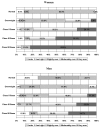Contributions of weight perceptions to weight loss attempts: differences by body mass index and gender
- PMID: 19188102
- PMCID: PMC2692706
- DOI: 10.1016/j.bodyim.2008.11.004
Contributions of weight perceptions to weight loss attempts: differences by body mass index and gender
Abstract
Previous studies have consistently observed that women are more likely to perceive themselves as overweight compared to men. Similarly, women are more likely than men to report trying to lose weight. Less is known about the impact that self-perceived weight has on weight loss behaviors of adults and whether this association differs by gender. We conducted a cross-sectional analysis among an employee sample (n=899) to determine the association of self-perceived weight on evidence-based weight loss behaviors across genders, accounting for body mass index (BMI) and demographic characteristics. Women were more likely than men to consider themselves to be overweight across each BMI category, and were more likely to report attempting to lose weight. However, perceiving oneself to be overweight was a strong correlate for weight loss attempts across both genders. The effect of targeting accuracy of self-perceived weight status in weight loss interventions deserves research attention.
Figures


References
-
- Andreasen AR. Marketing social change: Changing behavior to promote health, social development, and the environment. San Francisco, CA: Jossey-Bass; 1995.
-
- Bish CL, Blanck HM, Serdula MK, Marcus M, Kohl HW, 3rd, Khan LK. Diet and physical activity behaviors among Americans trying to lose weight: 2000 Behavioral Risk Factor Surveillance System. Obesity Research. 2005;13:596–607. - PubMed
-
- Bish CL, Michels Blanck H, Maynard LM, Serdula MK, Thompson NJ, Kettel Khan L. Health-related quality of life and weight loss among overweight and obese U.S. adults, 2001 to 2002. Obesity (Silver Spring) 2006;14:2042–2053. - PubMed
-
- Calle EE, Rodriguez C, Walker-Thurmond K, Thun MJ. Overweight, obesity, and mortality from cancer in a prospectively studied cohort of U.S. adults. New England Journal of Medicine. 2003;348:1625–1638. - PubMed
Publication types
MeSH terms
Grants and funding
LinkOut - more resources
Full Text Sources
Medical

